

Is This the Answer to Clean Water Shortages? A 17-Year-Old Invented This Smart Device That Makes Clean Water And Power At The Same Time. Around the world, many of the 783 million people who don't have clean drinking water also don't have access to electricity.
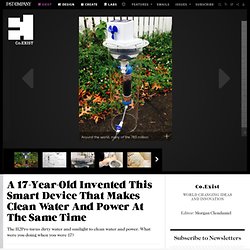
A new design from an Australian high school student aims to solve both problems at once: While the device purifies wastewater, it uses pollutants in the water to boost power production in a separate compartment. Paolo Lugari: Founder of Las Gaviotas (en espanol, with simultaneous English translation) Boyan Slat. “Human history is basically a list of things that couldn't be done, and then were done.” Boyan Slat (Delft, 1994) combines environmentalism, creativity and technology to tackle global issues of sustainability. Currently working on oceanic plastic pollution, he believes current prevention measures will have to be supplemented by active removal of plastics in order to succeed. “It will be very hard to convince everyone in the world to handle their plastics responsibly, but what we humans are very good in, is inventing technical solutions to our problems.
And that’s what we’re doing.” Student finds new way of turning plastic into biofuel. [CAIRO] A method for generating biofuel by breaking down plastics using a low-cost catalyst will be developed further in the United Kingdom next month (16 July).
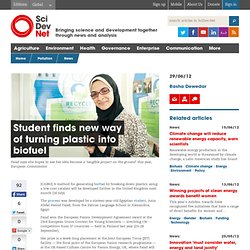
The process was developed by a sixteen-year-old Egyptian student, Azza Abdel Hamid Faiad, from the Zahran Language School in Alexandria, Egypt. Faiad won the European Fusion Development Agreement award at the 23rd European Union Contest for Young Scientists — involving 130 competitors from 37 countries — held in Finland last year (23–28 September). Her prize is a week-long placement at the Joint European Torus (JET) facility — the focal point of the European fusion research programme — at the UK-based Culham Centre for Fusion Energy, UK, where Faiad will present her project and receive help with its development. Science in Action Winner for 2013: Elif Bilgin. Elif Bilgin, winner of the 2013 Science in Action award, a $50,000 prize sponsored by Scientific American as part of the Google Science Fair.
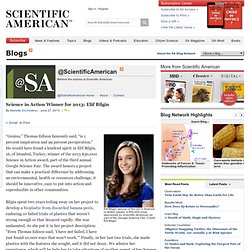
Credit: Elif Bilgin “Genius,” Thomas Edison famously said, “is 1 percent inspiration and 99 percent perspiration.” He would have found a kindred spirit in Elif Bilgin, 16, of Istanbul, Turkey, winner of the 2013 $50,000 Science in Action award, part of the third annual Google Science Fair. A Urine Powered Generator : Maker Faire Africa. Posted on Tuesday, November 6, 2012 · 168 Comments Possibly one of the more unexpected products at Maker Faire Africa this year in Lagos is a urine powered generator, created by four girls.
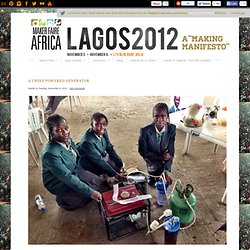
The girls are Duro-Aina Adebola (14), Akindele Abiola (14), Faleke Oluwatoyin (14) and Bello Eniola (15). 1 Liter of urine gives you 6 hours of electricity. The system works like this: The Secret of Trees. Dean Kamen. Dean L.
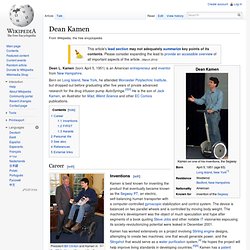
Kamen (born April 5, 1951) is an American entrepreneur and inventor from New Hampshire. Career[edit] Inventions[edit] Kamen is best known for inventing the product that eventually became known as the Segway PT, an electric, self-balancing human transporter with a computer-controlled gyroscopic stabilization and control system. The device is balanced on two parallel wheels and is controlled by moving body weight. Paul Lazarus. Dean Kamen's Water Purifier. Stanford R. Ovshinsky.
Stanford Robert Ovshinsky (November 24, 1922 – October 17, 2012) was a prolific American inventor and scientist who had been granted well over 400 patents over fifty years, mostly in the areas of energy and information.[1] Many of his inventions have had wide ranging applications.
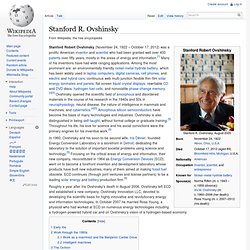
Roughly a year after Iris Ovshinsky's death in August 2006, Ovshinsky left ECD and established a new company, Ovshinsky Innovation LLC, devoted to developing the scientific basis for highly innovative and revolutionary energy and information technologies. In October 2007 he married Rosa Young, a physicist who had worked at ECD on numerous energy technologies including a hydrogen-powered hybrid car and on Ovshinsky's vision of a hydrogen-based economy.
Early life[edit] Ovshinsky was born and grew up in the industrial town of Akron, Ohio, then at the center of the American rubber industry. Work through the 1950s[edit] Work as a machinist and the Benjamin Center Drive[edit] Intelligent machines[edit] Ovshinksy Innovation LLC with Stan Ovshinsky. Stanford Ovshinsky, an Inventor Compared to Edison, Dies at 89. Self-taught African Teen Wows M.I.T. Donald Sadoway: The missing link to renewable energy. E. F. Schumacher. Ernst Friedrich "Fritz" Schumacher (16 August 1911 – 4 September 1977) was an internationally influential economic thinker, statistician and economist in Britain, serving as Chief Economic Advisor to the UK National Coal Board for two decades.[1] His ideas became popularized in much of the English-speaking world during the 1970s.
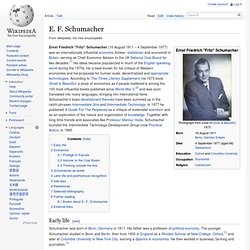
He is best known for his critique of Western economies and his proposals for human-scale, decentralized and appropriate technologies. According to The Times Literary Supplement, his 1973 book Small Is Beautiful: a study of economics as if people mattered is among the 100 most influential books published since World War II,[2] and was soon translated into many languages, bringing him international fame. Schumacher's basic development theories have been summed up in the catch-phrases Intermediate Size and Intermediate Technology. Early life[edit] Nikola Tesla.